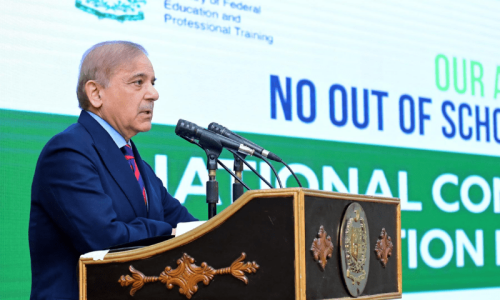
WHEN we think of Pakistani folklore two names pop up in our mind: Lok Virsa and Uxi Mufti. Lok Virsa, or National Institute of Folk and Traditional Heritage (NIFTH), Islamabad, is a federal government-funded organisation that had been working since long but was reconstituted in 2002 through a presidential order.
In NIFTH’s early phase, it was Uxi Mufti who worked tirelessly for preserving Pakistan’s indigenous heritage. He travelled across Pakistan with his tape recorder to preserve Pakistani folk songs and music, sometimes landing himself in precarious situations. A large number of books published by Lok Virsa in the 1980s and 1990s and even later on — preserving folk stories, songs and proverbs in Pakistani languages — are virtual treasures for the lovers of local heritage and culture but have long been out of print. Publication of new books by NIFTH has slowed down considerably and it must either reprint those golden oldies or display their digitised versions on its website. NIFTH also needs to give its own brief history on its website so that we could know exactly when it was established.
Folk means people and lore means a body of traditions and knowledge on a subject, says Concise Oxford English Dictionary. Lok, a slightly different version of the word log, or people, means exactly what folk means in English. Virsa, also pronounced varsa, means heritage. Hence, the nomenclature of Lok Virsa is quite apt but, ironically, NIFTH’s website has shied away from the local name while promoting local culture. Given Pakistan’s unusual cultural diversity, it is an overwhelming job that NIFTH has been entrusted with: to preserve and promote Pakistani culture and heritage. So, one must appreciate Lok Virsa’s untiring efforts to cope with the herculean task.
Folklore means the traditional beliefs and customs of a community that have been passed on by word of mouth generation after generation. The word lore also means stories, tales, traditions and legends. In broader sense, folklore includes the material heritage and artefacts as well as intangible cultural phenomena common to a culture, subculture or group. So folklore — by extended definition — includes customs, knowledge, superstitions, beliefs, values, social environment, arts, traditional skills, handicrafts, songs, dances, music, poetry, stories, legends, epics fairytales, fables, myths, riddles, proverbs, jokes, historical buildings, monuments and relics of a specific people.
Perhaps realising the enormous work that NIFTH has to carry out, some literary organisations indirectly lent a helping hand and published books on Pakistani culture and its literary aspects. These organisations include, among others, Markazi Urdu Board (renamed as Urdu Science Board), Anjuman Taraqqi-i-Urdu, Pakistan Academy of Letters and National Language Authority, (renamed as National Language Promotion department, or NLPD). These bodies have published books on Pakistani languages, translations from Pakistani languages into Urdu and English and some bilingual and multilingual dictionaries of Pakistani languages.
NLPD had launched an introductory series on Pakistani languages and their literatures many years ago and several works have so far been published in the series, covering the essence of linguistic and literary features of Pakistani languages, such as Punjabi, Sindhi, Balochi, Pashto, Brahvi, Hindko, Seraiki, Khwaar and some languages spoken in Gilgit-Baltistan. Now NLPD has come up with a new series named Pakistan Ki Lok Daastaanen (Folk Legends from Pakistan), which is aimed at introducing folk literature in Pakistani languages to a wider audience through Urdu.
The series starts with two books on folk legends: Punjabi and Balti. The book on Balti is penned by Muhammad Hasan Hasrat, a veteran scholar form the region. As Baltistan has some unique cultural and geographical features, the same are portrayed in the legends included in the book.
Hamidullah Hashmi, a senior scholar, has written the book on Punjabi legends. While the book captures the essence of popular Punjabi folk tales such as Heer Ranjha, Sohni Mahinwal and Mirza Sahiban, Pooran Bhagat would be quite new for those who are not abreast with Punjabi literature. The books are designed to convey the gist of popular folk tales and do it quite well.
Importance of folk literatures cannot be overemphasised as they are an essential part of folk culture. An integral part of a folk story or legend is the local colour since it preserves the ancient culture of a people and geography of their region, not to mention the local language. It depicts the local life and local society that breathed centuries ago. In some cases, the semi-historical legends narrate history and historical characters of a region, albeit they cannot be relied upon as lone historical source.
Folk literatures in Pakistani languages have some common traits, for instance, many folk tales have a touch of Sufism, stress human values and brotherhood, but, interestingly, some have a forceful narrative for resistance.
Published in Dawn, March 11th, 2024










































Dear visitor, the comments section is undergoing an overhaul and will return soon.